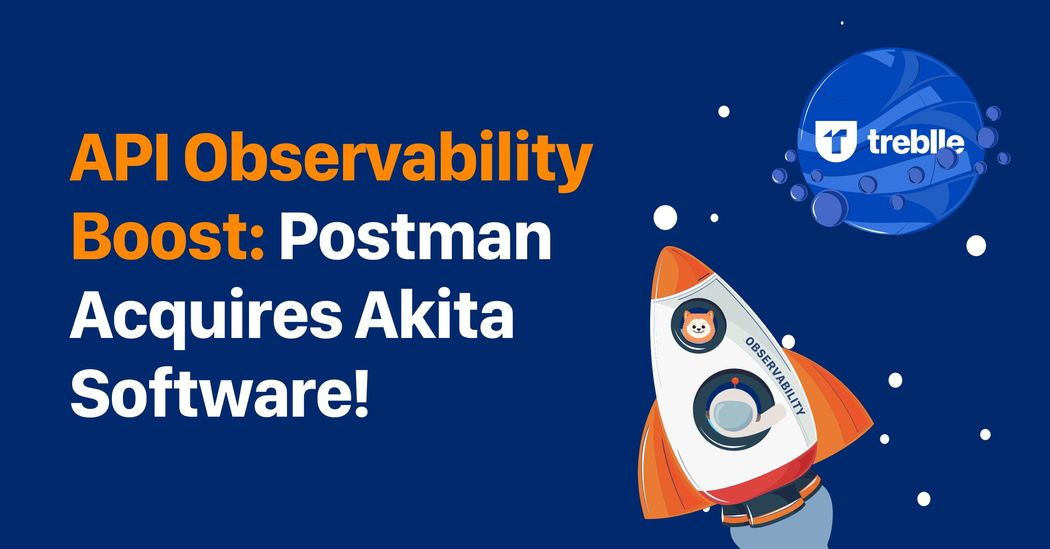Greetings, fellow API aficionados and trailblazers of technological transformation. I’ve been part of the API world for quite some time now, with a significant number of those years at Postman.
Over the last decade, I had a front-row seat to see developers and companies grappling with the challenges of managing the complex and ever-expanding number of APIs and intricate operations surrounding them. In this span of time, APIs have become the backbone of modern software development.
With that, the need for real-time insights into their performance has intensified.

API observability has emerged as the new frontier that empowers developers with deep insights into how APIs behave and interact. This ultimately leads to faster debugging and improved end-user experiences!
In a recent move, Postman, the API product used by millions of us developers for API testing, has acquired Akita Software, a budding startup in the domain of API monitoring and observability. I believe this acquisition further highlights the escalating need and significance of API observability in the fast-evolving technology landscape.
By integrating Akita's observability tooling into its suite of offerings, Postman is positioning itself to meet the burgeoning demand for enhanced visibility and control in the API development process.
This is a definite win-win that the entire API industry stands to gain from. I can’t wait to see how such collective knowledge will drive innovation and set new standards for APIOps practices across the board.
API Observability Relevance in 2023
Here and now at Treblle, I spend most of my time conversing about APIs and initiatives surrounding them with Engineering and Business leaders from various industries - think of large banks, big software companies, insurance firms, retail organizations, and many more.
As companies are entrenched in the realm of digital and API transformation, they have come to embrace the paradigm of API Operations, or as we fondly refer to it, APIOps. I can attest to its impact on streamlining API development, deployment, and management processes. One key pillar that towers over the landscape of APIOps in 2023 is API observability—an indispensable facet that ensures the continuous success of our endeavors.

Having navigated through the ever-evolving tech landscape for nearly 10 years from the lens of providing API solutions to developers and organizations, I’ll try to put together the top 5 trends that currently reign supreme in 2023
- Rapid adaptability to changing market demands: The API landscape is expanding rapidly, driven by the adoption of microservices and cloud-native architectures- all of this is opening up opportunities including growing using public and/or partner APIs to drive business outcomes. One example that comes to my mind is the work, Kroger, yes- the supermarket company has been doing to enhance customer experiences and allow developers to use Kroger services in whichever experience they are comfortable with. They offer a suite of products that allow third parties to tap into the Kroger ecosystem with a wide variety of APIs from Public APIs for anyone to use to more advanced capabilities(Partner APIs) for strategic partners.
- Focus on User Experience: Customer-centricity is a driving force in 2023, and understanding API data plays a pivotal role in optimizing user experiences by proactively detecting and resolving issues, and driving innovation and growth. APIs are the way to modernize user experiences in traditional industries with legacy systems. I’ve been following Allianz’s(the financial services giant) journey for a long time now and their take on digitization is pretty rad. It could be either Allianz Direct using APIs and microservices to build a technology platform that is flexible for building great user experiences or Allianz Insurance open sourcing Allianz Business Systems(ABS) core.
- Real-time Decision-making with Observability Data: In 2023, businesses will leverage API observability to harness actionable insights from monitoring data. This empowers teams to make data-driven decisions, optimize performance, enhance API reliability, and grow API products faster than ever before. No wonder why API Product Manager is the hottest tech role.
- Security as a Top Priority: Cyber threats continue to evolve, underscoring the importance of comprehensive API observability in detecting and mitigating potential security breaches, safeguarding sensitive data, and maintaining compliance. Take a look at my colleague Chri’s post that will keep you awake at night.
- AI and ML Integrations: Businesses are leveraging Artificial Intelligence (AI) and Machine Learning (ML) to extract actionable insights from data enabling predictive analytics and enhancing decision-making processes. Through APIs, AI algorithms can access and analyze complex data streams, making real-time predictions and providing early warnings for potential issues. This predictive prowess enhances businesses' ability to proactively address challenges and improve operational efficiency. We are all in on AI at Treblle so let me introduce you to my buddy, Alfred. Alfred knows OpenAPI really well and can get you answers from basic to advanced questions including generating code in any language or framework.
The Future is more APIs
To stay competitive and future-proof their operations, businesses must invest in API-first strategies, prioritize API development, and adopt a mindset that values openness and collaboration. By doing so, they can unlock the full potential of APIs and drive growth, innovation, and success in the digital age for companies of all sizes and industries to ensure product quality and avoid errors or downtimes.

When speaking with our user community, something I keep hearing time and again is that developers really care about jobs to be done and they want to be exceptional at what they do - from building APIs and debugging them to scaling them. So do companies of all sizes! They all want to be faster in development, build modern customer experiences, automate everything, and more. It’s another post in itself.
The point is, technology continues to evolve and APIs will remain the linchpin that connects applications, services, and devices. The future is undoubtedly more APIs, and businesses embracing this interconnectedness will be better positioned to succeed in the digital era.

API observability makes your API(s) observable and ensures you have success with your APIs. You see what’s up in real-time rather than monitoring, a predefined set of metrics that need context while trying to make decisions or take action. These could be debugging or improving applications systems in engineering or analyzing patterns and driving product growth in the business context.
Observability on the other hand is like having a magic window in a system. It helps us understand what's happening inside, even if we don't see everything directly. An API can be considered observable when we have enough clues to figure out what's going on.
With observability, we can peek into the system, make improvements, and keep everything running smoothly. It's like having a superpower for system insights!






